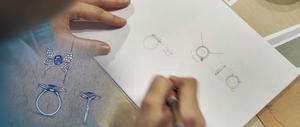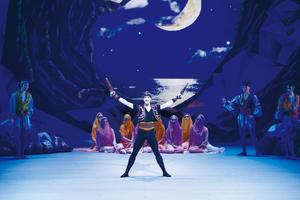Artists, writers and actors who suddenly found themselves involuntarily isolated because of COVID-19 find new sources of inspiration and creativity as they become free of real-world distractions. Wang Yuke reports from Hong Kong.
 Ava Chan soaks herself in the “me time” to let creative ideas flow. (PHOTO PROVIDED TO CHINA DAILY)
Ava Chan soaks herself in the “me time” to let creative ideas flow. (PHOTO PROVIDED TO CHINA DAILY)
Lam Yiu-leung looked out at a changed world, plagued by thoughts of what a grim place it had become. The successful play he wrote was his way of working through the despairing imagery that haunted him through months of quarantine and isolation. The play is about an estranged couple that becomes reunited, finding new life together in a world becoming obsessed with death. “Plays cannot be written without alone time,” Lam said.
One of the great disruptions of the global COVID-19 pandemic is the loss of connectivity. Countless reports detail how many people are reaching out to reconnect with old acquaintances, needing the warmth of human response. That caught Lam’s eye, and that is what he set out to depict.
Lam’s play opens as a husband appears in the doorway of his wife’s quarters, and presents her with some face masks as safeguards against the plague. She invites him to come in. They talk and have supper together.
For all of the gloom that hangs over every nation and the prospect that life may never be the same, Lam, who saw little light for the future, found a glimmer at home. “Working in seclusion helped me recover my distinctive voice,” Lam said. He had become inundated by the confusing and often conflicting messages from his personal sounding board, so he redirected himself and found new energy to create works true to his heart.
 The initial engagement ring designed by Ava Chan, a local independent jewelry designer. She prefers to spend alone time sketching designs on paper. (PHOTO PROVIDED TO CHINA DAILY)
The initial engagement ring designed by Ava Chan, a local independent jewelry designer. She prefers to spend alone time sketching designs on paper. (PHOTO PROVIDED TO CHINA DAILY)
Healing art
Creativity is the ability to fashion something novel and original by challenging common knowledge. It emphasizes “individuality”, said Chen Zhansheng, associate professor of psychology at the University of Hong Kong.
To create highly personal, original works, creative people need to disengage and spend some time away from outside influences, Chen said. He added that it is in isolation that people often discover what is true to them. “Then we can zero in,” Chen said. For some needing to “break out”, the lockdown created an oasis of tranquility, where the psychological retreat could happen.
Solitude allows me to see how deep I can go in my mind and discover what’s there, in the space of imagination
Jonathan Spigner, a dancer for the Hong Kong Ballet
“Time spent alone helps us retain our independent views,” said Jack Goncalo, professor of business administration at the University of Illinois.
Writing proved to be Lam’s safety valve, a release for the toxic, soul-destroying influences brought by a life of fear and isolation. Instead of letting himself be overwhelmed, he set out to portray his vision of a “better world.” His most persistent thought during his isolation is reflected in a dialogue given to the husband, in his play: “Someday the pandemic will end, but I see no light now along the path, and that is what distresses me.”
“That’s actually how I felt,” Lam said.
Art has the power of relieving negative emotions and feelings.
As COVID-19 lingers, people hope for a “better world”, Chen said. Arts provide not only an escape from the misery, but an inclusive medium for either venting negativities or communicating utopian hopes.
Mercy Wong, an actress at the Hong Kong Repertory Theatre, spent her time in isolation more closely examining her native talent for mimicry — a talent shared among the best performers. She’s a keen observer.
“When I was on the street, I watched people,” she said. Wong noticed the “selfish gene” expressed by many, even at a time of crisis, like the people who shed their face masks when they sneezed. “I was upset. They showed no regard for people around them. It made no sense amid the intensity of the pandemic. They’re self-absorbed,” Wong said. “I’ll incorporate this in my performances if I am called to portray a selfish, mean, inconsiderate person in the future.”
 Jonathan Spigner plays the role of Birbanto, a bad guy in Le Corsaire, in 2017. (CONRAD DY-LIACCO / FOR CHINA DAILY)
Jonathan Spigner plays the role of Birbanto, a bad guy in Le Corsaire, in 2017. (CONRAD DY-LIACCO / FOR CHINA DAILY)
Solitude feeds creativity
Creative people find time for introspection and reflection in solitude. Wong said it’s vital for stage performers to look more deeply into their experiences of other people. It allows them to calibrate their techniques. Confined to her home, Wong looked back, revisiting how she played roles in the past. “I got a ‘eureka moment’ at some points, like, ‘Ah, I should have played it this way instead of that.’ ... If I had projected this emotion onto that role, the result would have been better.”
Notable geniuses embraced solitude and projected immortal images revealing their world views. Vincent van Gogh, the Dutch post-impressionist painter, spent his most prolific years isolated in the city of Arles, in southern France. The German poet and playwright Johann Wolfgang von Goethe said: “One can be instructed in society, but is inspired only in solitude.” Pablo Picasso declared, “Without great solitude, no serious work is possible.” During the Great Plague, Isaac Newton formulated a theory of universal gravitation in isolation as campuses were closed.
Ava Chan, a local independent jewelry designer and artisan, spent weeks of her solitude weighing, assessing, experimenting and revising her design for matching rings, commissioned by a couple to mark their 10th anniversary.
When Chan presented her hand-drawn sketch, the couple gave their enthusiastic approval. The drawing was annotated with descriptions as to the precise shape, color and dimensions of the rings.
The couple wanted to reinforce their commitment to each other, with a strong “personal” statement. Chan sat down with the couple and brainstormed, asking them to share fond memories or objects or symbols with special meanings for them.
“Their input triggered a barrage of ideas.” But sometimes, too much is too little. “I settled myself down in seclusion, filtered the ideas, and morphed them into design,” Chan said. What she picked from a tangle of inspirations was “simplicity”, an input from the wife and “an exquisite design that can allude to the 10th anniversary”, a suggestion from the husband. She also took away the impression that the couple called each other “honey”.
The resulting work is a pair of honey-color gemstone rings, with the ring’s prongs forming an “X” — the Roman numeral 10. It can be seen only from beneath. Flanking the signet ring are 10 delicate lines, neatly arranged.
“I worked most of the time alone. The peaceful time alone set me in flow,” Chan said. “I spent just a week finalizing the design. Normally, it would take two weeks to a month because there were always surrounding distractions.” The isolation, she reflects, allowed her to focus, uninterrupted on her design, and “eureka moments” became more frequent.
What overwhelmed Chan as she took up her assignment was “choice overload”, Goncalo said. His research focuses on creativity of individuals and of teams. He has been published in academic journals. He told China Daily that when we’re bewildered by an overabundance of choice or so much input from outside, solitude helps us to ignore more of the input from others and focus on ideas we truly appreciate. “When you ask someone to be creative, they actually look within themselves and think about ideas that reflect their unique points of view. And that’s better done in solitude,” Goncalo said.
We’ve accumulated a backlog of ideas absorbed from our experiences, Goncalo said. In the perforce solitude of the lockdown, some have been able to focus and synthesize all inputs and bring them to realization. “Synthesis” is putting together the ideas scattered around into a final product. “To be really creative, we can’t combine all ideas (whether from within us or outside) at random,” added Goncalo. To synthetize, we look within ourselves, sort out only the options that can reflect our points of view, and assemble them into a full-blown idea, he said.
Art that is intrinsically active and communal can get a kick out of alone time.
In the fast-paced city, everyone was always busy, busy, busy. The frenetic, goal-driven pace of Hong Kong living became somewhat notorious. During the pandemic, people started fidgeting.
“Especially for us performers, it feels like there’s no air to breathe (performances having been canceled). It feels like… purpose is taken away,” said Jonathan Spigner, a dancer with the Hong Kong Ballet. He hastens to add: “But really, being bored sometimes is good. … Not needing to do anything allows reflection, and through reflection we’re able to grow, prosper more, and realize more, until into the depths, where we get to know the true meaning of what we’re doing. … We thought we knew that, but I think it’s always under layers.” Boredom, he said, for sure helps dance choreographers peel away the next layer of the onion.
 Jonathan Spigner rehearses for Hong Kong Cool in 2018. (S2 PRODUCTION / FOR CHINA DAILY)
Jonathan Spigner rehearses for Hong Kong Cool in 2018. (S2 PRODUCTION / FOR CHINA DAILY)
Alone or lonely?
The state of aloneness can extend one’s imagination, to realize a world of potentials otherwise obscure. “Solitude allows me to see how deep I can go in my mind and discover what’s there in the space of imagination,” Spigner said. Creative people are better at identifying connections among things that don’t appear linked from any superficial perspective. Neuroscience also tells that the brain region responsible for making associations is more active in creative minds. Creative minds also exhibit willpower in meditation and discipline of mind. After all, the more deeply one is able to meditate, the more connections between seemingly unrelated things can be secured.
“I often have many ideas, but just on the surface,” Spigner said. The city’s lockdown inadvertently “gave me time to ponder them until the ideas became complete.” He describes the process as “exciting”.
Dancers, like writers, have the luxury of infusing emotion into their work. “It’s good and bad,” Spigner said. When he played Birbanto, a bad guy in Le Corsaire, he had recently broken up with his girlfriend. “It was frustrating, because it was she who broke up with me. So, I felt denied.” Almost automatically, that negative energy went into the role. “Birbanto has the same issue with the pirate captain. So, I can correlate that, and use that energy to project his personality.” It turned out to be a success.
“Creating essentially, is a lonely art. To some it’s a blessing, to some a curse. It is, in reality, the ability to reach inside yourself and drag forth from your very soul an idea,” Lou Dorfsman, a late renowned graphic designer, was quoted as saying.
So is the “lonely art” a blessing or a curse? The answer lies in the nuance between aloneness and loneliness. Loneliness and being alone are different. “Lonely” is a subjective description of one’s feelings. People with the complaint of “loneliness” find time alone tortuous. “Alone” is an objective description of a state of being. The one describing himself “alone” may not feel lonely but rather, able to enjoy the time, even to benefit from it. The late theologian Paul Tillich’s words express that: Language has created the word “loneliness” to express the pain of being alone. And it has created the word “solitude” to express the glory of being alone.
There’s a fine line between the two states of mind, Chen said. “Solitude is beneficial only if one ‘enjoys’ it,” he said. “Only when the solitude is voluntary and welcome can we feel the sense of high autonomy and liberty in whatever we’re doing.” The autonomy fuels creativity, as ideas tend to flow when we let our guard down. “When we’re alone in a relaxing frame of mind, we tend not to care about how other people receive our works. Without the fear of eye rolls, our mind is likely to freewheel.” But on the other hand, if loneliness takes the upper hand, creativity and productivity will be sabotaged.
Elyakim Kislev, a professor at the Hebrew University of Jerusalem, has devoted his studies to the association between solitude and well-being. After interviewing many people for his book Happy Singlehood, he concludes that “it is possible to achieve a high level of well-being by developing the ability to enjoy ‘me time’. Often, this results in feelings of empowerment, relaxation, and self-knowledge — not loneliness.”
While we cannot say with certainty that solitude can shape the creative idea of one individual, it’s pretty certain that without solitude, the creative light may shine, but dimly.
Contact the writer at jenny@chinadailyhk.com


